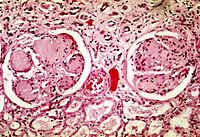
Photo from wikipedia
Background Antihypertensive treatment mitigates the progression of chronic kidney disease. Here, we comparatively assessed the effects of antihypertensive agents in normotensive and hypertensive diabetic patients with microalbuminuric kidney disease. Methods… Click to show full abstract
Background Antihypertensive treatment mitigates the progression of chronic kidney disease. Here, we comparatively assessed the effects of antihypertensive agents in normotensive and hypertensive diabetic patients with microalbuminuric kidney disease. Methods MEDLINE, EMBASE, and the Cochrane Central Register of Controlled Trials were systematically searched for randomized controlled trials (RCTs) comparing oral antihypertensive agents in adult diabetic patients with microalbuminuria. The primary efficacy outcome was reduction in albuminuria, and the primary safety outcomes were dry cough, presyncope, and edema. Random-effects pairwise and Bayesian network meta-analyses were performed to produce outcome estimates for all RCTs, only hypertensive RCTs, or only normotensive RCTs. Surface under the cumulative ranking (SUCRA) probability rankings were calculated for all outcomes. Sensitivity analyses on type 2 diabetes status, age, or follow-up duration were also performed. Results A total of 38 RCTs were included in the meta-analyses. The angiotensin-converting enzyme inhibitor-calcium channel blocker (ACEI-CCB) combination therapy of captopril+diltiazem was most efficacious in reducing albuminuria irrespective of blood pressure status. However, the ACEI-angiotensin receptor blocker (ACEI-ARB) combination therapy of trandolapril+candesartan was the most efficacious in reducing albuminuria for normotensive patients, while the ACEI-CCB combination therapy of fosinopril+amlodipine was the most efficacious in reducing albuminuria for hypertensive patients. The foregoing combination therapies displayed inferior safety profiles relative to ACEI monotherapy with respect to dry cough, presyncope, and edema. With respect to type 2 diabetic patients with microalbuminuria, the Chinese herbal medicine Tangshen formula followed by the ACEI ramipril were the most efficacious in reducing albuminuria. Conclusions Trandolapril+candesartan appears to be the most efficacious intervention for reducing albuminuria for normotensive patients, while fosinopril+amlodipine appears to be the most efficacious intervention for reducing albuminuria for hypertensive patients. For practitioners opting for monotherapy, our SUCRA analysis supports the use of trandolapril and fosinopril in normotensive and hypertensive adult diabetic patients with microalbuminuria, respectively.
Journal Title: PLoS ONE
Year Published: 2017
Link to full text (if available)
Share on Social Media: Sign Up to like & get
recommendations!